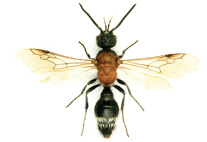Abstract
Males of Ruizantheda Moure sensu lato differ from males of other Caenohalictina in having the outer gonostylar plate with a large membranous region that extends to the ventral region, and the ventral gonostylus in the form of a retrorse lobe. These features permit the placement of three new species described here in the genus in this broader sense. However, despite having simple mandibles, they do not have the traits considered as apomorphies of Ruizantheda s. str. or Ruizantheda + Oragapostemon Cure by earlier authors, and neither do they possess features of Ruizanthedella Moure. Moreover, in the new species, the outer gonostylar plate is short, ending before the apex of the main gonostylar lobe and has long setae on its dorsal surface, while in other Ruizantheda, the outer gonostylar plate extends beyond the apex of the main gonostylar lobe and lacks setae. Additionally, two of the new species have a distribution different from those of most Ruizantheda—Ruizantheda inca n. sp. is found in Ancash, Peru and R. aerugineus n. sp. in the state of Minas Gerais, Brazil. Instead of including the three species in a new genus, we believe that it is more reasonable to maintain the status of Ruizantheda sensu Michener and until a new phylogenetic analysis of the entire subtribe, inclusive of the species newly established here, is completed. The three new species, known only by the male, are described and illustrated, and a key to the species of Ruizantheda s. l. is provided. The homologies between the gonostylar structures, mainly those related to the dorsal gonostylar process, of males of Ruizantheda, Caenohalictus Cameron, and Pseudagapostemon Schrottky are discussed.

